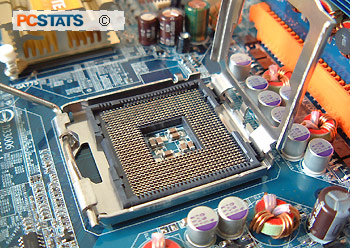Intel
introduced many new features with the Prescott core to try and quash the
negative affects of its longer pipeline. For instance, the L1 data cache was
doubled from 8KB to 16KB, and it is now 8-way associative instead of
4-way. Intel also increased the L2 cache from 512KB to a full 1MB.
As mentioned earlier, cache helps to hide the
execution pipeline which has been increased by more than 50%, up from the 20
stages on the Northwood core to a full 31 stages. On-core cache memory keeps
frequently accessed data close to the processor so it can be retreived quickly,
much, much faster than would be the case from the main system memory or hard
disk.
A feature that's found within Prescott Pentium 4
CPUs (and currently nowhere else) is SSE3 technology. SSE3 adds 13 new instructions to
the core which should improve application performance once programs are written
to take advantage of the new instruction set.
With Intel's sway, I think it's safe to assume
software developers will adapt soon, after all SSE and SSE2 friendly programs
were quick to show up. SSE3 also works in conjunction with HyperThreading
technology to improve the overall efficiency of the processor. AMD does not
currently support SSE3 in its processor products, but the company soon
will.
The chip we'll never know... Tejas
As I'm sure
you're aware, Intel's next generation Pentium 4 processor, which was code named Tejas,
was cancelled as was the whole Pentium 4/Net Burst architecture! This was done
because of the problems associated with 0.09 micron manufacturing
Intel
simply could not bring down the power consumption requirements of the Pentium 4,
and the numbers floating around the web had it at around 150W! Another problem
with drawing that much power is the amount of heat the processor produces. Even
with high-end air cooling in a well ventilated case, temperatures would soar
well past the 50 degree Celsius mark.
A second
nail in the coffin of Tejas was reportedly the ongoing success of AMD's 64-bit
processor lines, the Opteron and Athlon 64/FX. These 64-bit chips revolutionized the industry by supporting both 32
and 64 bit software interchangeably. Up until very recently, Intel has been suffering
from the lack of an equivalent product, and the Tejas core was killed partially
to throw more support behind Intel's effort to release its own 64-bit/32-bit
compatible processor under the label of EMT64 - Extended Memory Technology
64-bit.
At the
time, there was no
easy fix in sight for these issues. Intel stood to lose a lot of money so it took the unusual step
of cancelling a whole line and adopting the more efficient Pentium M core
into its desktop roadmap.
Consequently, Intel's dual core Pentium 4 desktop
processors have just been introduced, and are primed and ready to
offer serious competition to AMD's dual core Athlon64 X2 processors. Had
Tejas gone ahead, Intel may have been shut out of game in this regard.
